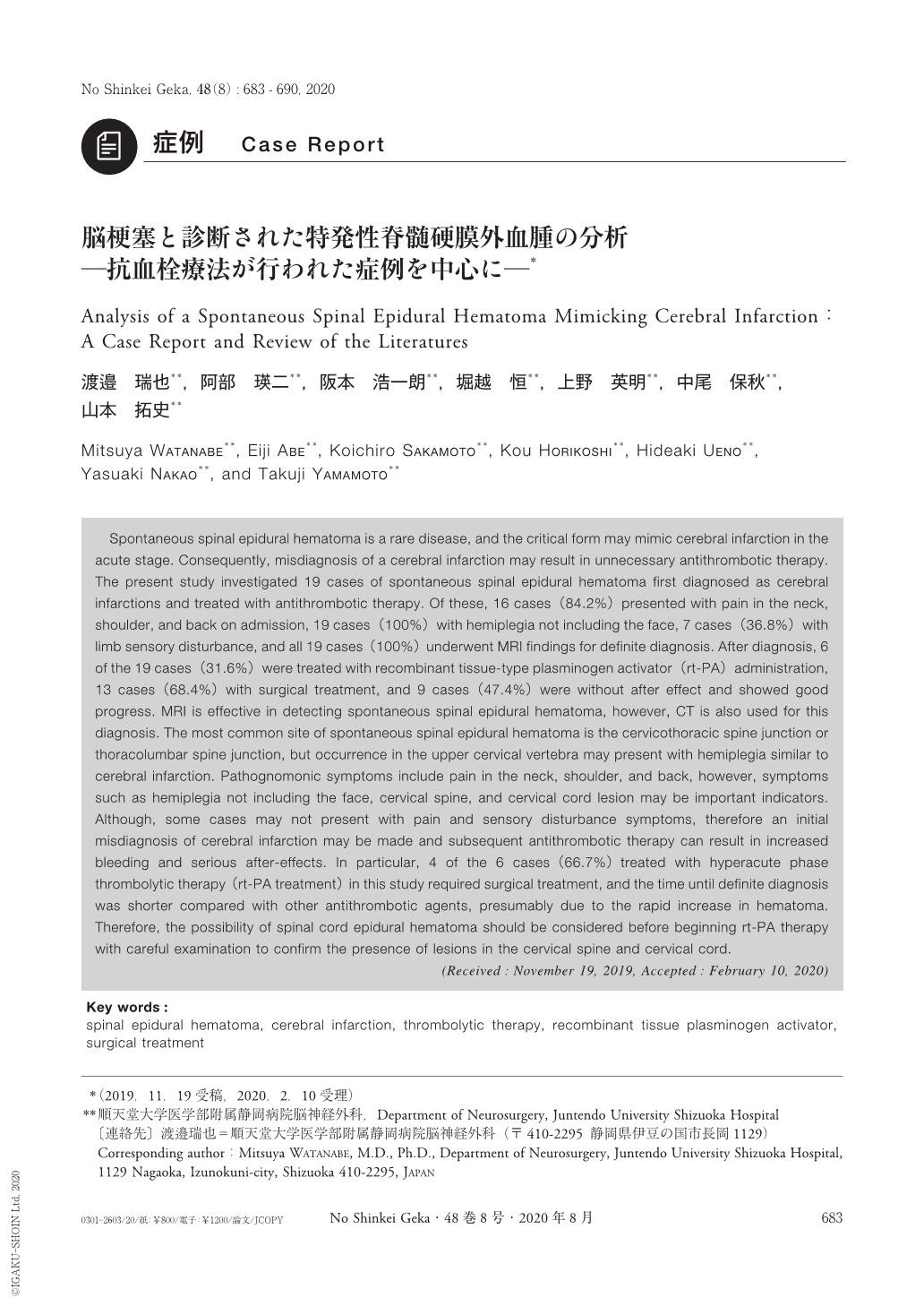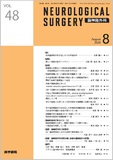Japanese
English
- 有料閲覧
- Abstract 文献概要
- 1ページ目 Look Inside
- 参考文献 Reference
Ⅰ.はじめに
特発性脊髄硬膜外血腫は,突然の後頚部や背部痛に続き,四肢の不全麻痺,感覚障害や膀胱直腸障害などの神経症状が急速に進行する稀な疾患である2,10).発生頻度が低く認知度も低いことに加えて,発症様式や神経症状が脳梗塞と酷似していることから,診断に難渋することも少なくない.的確な診断を行わないと,出血性病変に対して抗血栓療法が行われてしまうこととなり,結果として出血の増大を来し,重大な後遺症をもたらす可能性があるため注意が必要である.近年の報告においても,脳梗塞との鑑別が困難であったとする例11)や,実際に脳梗塞と診断され抗血栓療法が行われた例4,6-8,13-24)も少なからず報告されている.
今回われわれは,片麻痺で発症し,脳梗塞と判断し血栓溶解療法が行われた後に,特発性脊髄硬膜外血腫と診断された症例を経験した.脳梗塞と診断され抗血栓療法が行われた既知の症例と比較分析し,再発防止を踏まえて考察したので報告する.
Spontaneous spinal epidural hematoma is a rare disease, and the critical form may mimic cerebral infarction in the acute stage. Consequently, misdiagnosis of a cerebral infarction may result in unnecessary antithrombotic therapy. The present study investigated 19 cases of spontaneous spinal epidural hematoma first diagnosed as cerebral infarctions and treated with antithrombotic therapy. Of these, 16 cases(84.2%)presented with pain in the neck, shoulder, and back on admission, 19 cases(100%)with hemiplegia not including the face, 7 cases(36.8%)with limb sensory disturbance, and all 19 cases(100%)underwent MRI findings for definite diagnosis. After diagnosis, 6 of the 19 cases(31.6%)were treated with recombinant tissue-type plasminogen activator(rt-PA)administration, 13 cases(68.4%)with surgical treatment, and 9 cases(47.4%)were without after effect and showed good progress. MRI is effective in detecting spontaneous spinal epidural hematoma, however, CT is also used for this diagnosis. The most common site of spontaneous spinal epidural hematoma is the cervicothoracic spine junction or thoracolumbar spine junction, but occurrence in the upper cervical vertebra may present with hemiplegia similar to cerebral infarction. Pathognomonic symptoms include pain in the neck, shoulder, and back, however, symptoms such as hemiplegia not including the face, cervical spine, and cervical cord lesion may be important indicators. Although, some cases may not present with pain and sensory disturbance symptoms, therefore an initial misdiagnosis of cerebral infarction may be made and subsequent antithrombotic therapy can result in increased bleeding and serious after-effects. In particular, 4 of the 6 cases(66.7%)treated with hyperacute phase thrombolytic therapy(rt-PA treatment)in this study required surgical treatment, and the time until definite diagnosis was shorter compared with other antithrombotic agents, presumably due to the rapid increase in hematoma. Therefore, the possibility of spinal cord epidural hematoma should be considered before beginning rt-PA therapy with careful examination to confirm the presence of lesions in the cervical spine and cervical cord.

Copyright © 2020, Igaku-Shoin Ltd. All rights reserved.


